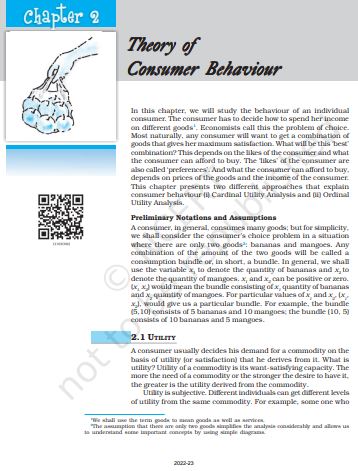‘Theory Of Consumer Behaviour NCERT Class 12 Economics Chapter 2 Solutions‘ PDF Quick download link is given at the bottom of this article. You can see the PDF demo, size of the PDF, page numbers, and direct download Free PDF of ‘Ncert Class 12 Economics Chapter 2 Exercise Solution’ using the download button.
Theory Of Consumer Behaviour NCERT Textbook With Solutions Book PDF Free Download

Chapter 2: Theory Of Consumer Behaviour
A consumer usually decides his demand for a commodity on the basis of utility (or satisfaction) that he derives from it.
What is utility? The utility of a commodity is its want-satisfying capacity. The more the need of a commodity or the stronger the desire to have it, the greater is the utility derived from the commodity.
The utility is subjective. Different individuals can get different levels of utility from the same commodity.
For example, someone who likes chocolates will get much higher utility from chocolate than someone who is not so fond of chocolates, Also, a utility that one individual gets from the commodity can change with change in place and time.
For example, utility from the use of a room heater will depend upon whether the individual is in Ladakh or Chennai (place) or whether it is summer or winter (time).
Cardinal utility analysis assumes that level of utility can be expressed in numbers. For example, we can measure the utility derived from a shirt and say, this shirt gives me 50 units of utility.
Before discussing further, it will be useful to have a look at two important measures of utility.
Measures of Utility Total Utility: Total utility of a fixed quantity of a commodity (TU) is the total satisfaction derived from consuming the given amount of some commodity x.
More of commodity x provides more satisfaction to the consumer. TU depends on the quantity of the commodity consumed. Therefore, TUn refers to total utility derived from consuming n units of a commodity x.
Marginal Utility: Marginal utility (MU) is the change in total utility due to consumption of one additional unit of a commodity.
For example, suppose 4 bananas give us 28 units of total utility and 5 bananas give us 30 units of total utility.
Clearly, consumption of the 5th banana has caused the total utility to increase by 2 units (30 units minus 28 units). Therefore, the marginal utility of the 5th banana is 2 units.
Cardinal utility analysis is simple to understand, but suffers from a major drawback in the form of quantification of utility in numbers. In real life, we never express utility in the form of numbers.
At the most, we can rank various alternative combinations in terms of having more or less utility. In other words, the consumer does not measure utility in numbers, though she often ranks
various consumption bundles. This forms the starting point of this topic – Ordinal Utility Analysis.
It may be mentioned that the law of Diminishing Marginal Rate of Substitution causes an indifference curve to be convex to the origin.
This is the most common shape of an indifference curve. But in case of goods being perfect substitutes4, the marginal rate of substitution does not diminish. It remains the same.
| Author | NCERT |
| Language | English |
| No. of Pages | 28 |
| PDF Size | 3.5 MB |
| Category | Economics |
| Source/Credits | ncert.nic.in |
NCERT Solutions Class 12 Economics Chapter 2 Theory Of Consumer Behaviour
1. What do you mean by the budget set of a consumer?
A budget set of a consumer is a bundle of two or more goods in certain quantities and combinations that is desirable and affordable for the consumer based on their price range. A budget set is also called as an opportunity set.
2. What is budget line?
A budget line is a graphical representation of a consumer’s constraints when buying a combination of two or more products with a given budget.
A budget line will shift whenever there is a change in the prices, preferences or income. It is also called a consumption possibility line. Here, it is assumed that the customer spends the entire income on the bundle of products.
3. Explain why the budget line is downward sloping.
With a limited income, the customer can increase the consumption of one good only by decreasing the consumption of the other good. This is why a budget line is downward sloping.
NCERT Class 12 Economics Textbook Chapter 2 Theory Of Consumer Behaviour With Answer PDF Free Download
